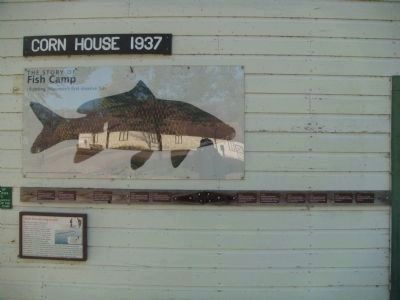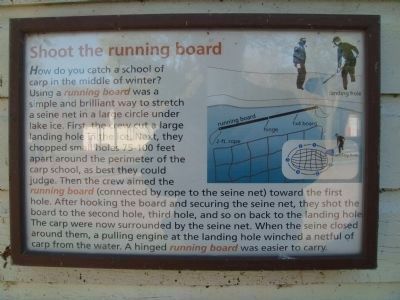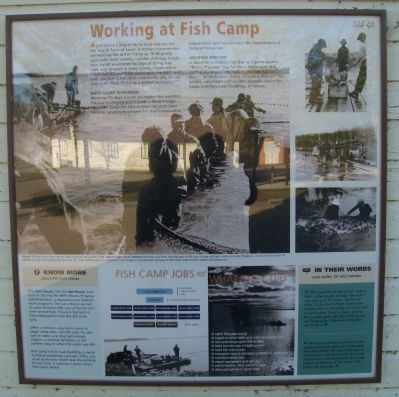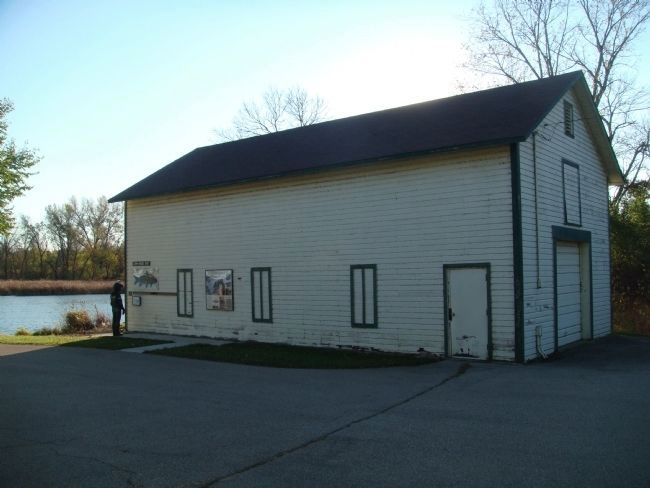Near McFarland in Dane County, Wisconsin — The American Midwest (Great Lakes)
Working at Fish Camp
Hard Work Rewarded
Working 5½ days a week no matter the weather, Fish Camp crewmembers made a decent wage. Many fish camp workers around the state later became fisheries employees for the Conservation Department and its successor, the Department of Natural Resources.
Goofing Around
A favorite recreation was the card game euchre. "Riding the keg" was far more dangerous and daring. During winter seining, workers cut ice blocks to reach open water. A truck pulled out the blocks, sometimes with a rider aboard--when the camp foreman wasn't looking, of course.
Know More about the Corn House
The Corn House, like the Net House, was built in 1937 by the WPA (Works Progress Administration, a depression-era federal work program). The Corn House earned its name because milk cans of kernel corn were stored here. The corn fed carp in the holding pond until the fish were sold.
Often a netman--staying in camp to repair seine nets--fed the carp. He also had to make sure they had enough oxygen, a common problem on hot summer days or when the water was still.
Fish Camp's third main building, a metal building containing a garage, office and small bunkroom, stood near the parking lot entrance. It was taken down when Fish Camp closed.
Fish Camp Jobs and What They Did
camp supervisor { ° personnel ° administration ° pay
foreman { in charge of fishing operations
conservation aide { work seines
seasonal worker { work seines
° catch fish year-round
° travel to other lakes and rivers to harvest fish
° sort and return sport fish to lake
° feed corn to carp in holding pen
° load fish into trucks
° transport carp to railroads in Madison, Janesville
° maintain seine nets
° repair equipment and vehicles
° patch waders, other personal gear
° play card games in spare time
IN THEIR WORDS carp scales, tar and netmen
"[The experience] was great. I was a little embarrassed, though, because I was dating at the time--my future wife. I'd go over to their house after loading fish on Saturday and I'd be full of carp scales. I had to clean up first. But I could never get rid of the tar in my fingernails. [Nets were tarred to last longer.]"
"When you became
a netman, your salary, of course, came up, it was very rate dependent. Because when you'd pull seines in the lake you'd run across obstructions and sometimes tear huge holes half the size of this room. This had to be repaired."
[Caption for photos:] Above: Pulling in the lead line on Lake Kegonsa, November 1934. Above right, top to bottom: Moving carp from holding pen to fish box. Barge pulling in seine on Lake Waubesa, motor-driven winch in middle of boat. Removing carp by seine net from holding pen for shipment, Lake Kegonsa. All photos courtesy of Wisconsin Department of Natural Resources.
Erected by Dane County Parks.
Topics and series. This historical marker is listed in these topic lists: Environment • Industry & Commerce. In addition, it is included in the Works Progress Administration (WPA) projects series list. A significant historical year for this entry is 1937.
Location. 42° 58.968′ N, 89° 15.913′ W. Marker is near McFarland, Wisconsin, in Dane County. Marker can be reached from Fish Camp Road, 0.3 miles County Highway AB, on the right when traveling east. The marker is in Fish Camp Park. Touch for map. Marker is at or near this postal address: 3383 Fish Camp Road, Mc Farland WI 53558, United States of America. Touch for directions.
Other nearby markers. At least 8 other markers are within 3 miles of this marker, measured as the crow flies. How to catch 30,000 carp (a few steps from this marker);

Photographed By William J. Toman, October 16, 2011
3. The Story of Fish Camp Marker
The subcaption reads "fighting Wisconsin's first invasive fish." The timeline under the marker reads as follows:
1877
Germany and begins raising them.
1880
Nine Springs (now Nevin) Fish Hatchery in Madison receives 75 carp from the U.S. Fisheries Commission.
1880-1894
Carp raised at Madison's fish hatchery are stocked in Wisconsin waters, most in Madison's chain of lakes.
1895
Carp introduction is halted when it becomes clear the fish are harming the state's sport fishery.
1899
The Wisconsin Fisheries Commission issues permits to harvest common carp.
1912
The Wisconsin Fisheries Commission contracts with commercial fishers to remove carp.
1934
Wisconsin Conservation Department funds removal of carp and other rough fish by establishing fish camps.
1937
The Corn House and Net House are built to support a fish camp several miles up the Yahara River.
1954
Fish Camp becomes a full-scale operation when the nearby Yahara River camp relocates here.
1969
Fish Camp closes because the carp market is no longer economical.
1976
Fish Camp County Park opens to the public for lake recreation.
1877
Germany and begins raising them.
1880
Nine Springs (now Nevin) Fish Hatchery in Madison receives 75 carp from the U.S. Fisheries Commission.
1880-1894
Carp raised at Madison's fish hatchery are stocked in Wisconsin waters, most in Madison's chain of lakes.
1895
Carp introduction is halted when it becomes clear the fish are harming the state's sport fishery.
1899
The Wisconsin Fisheries Commission issues permits to harvest common carp.
1912
The Wisconsin Fisheries Commission contracts with commercial fishers to remove carp.
1934
Wisconsin Conservation Department funds removal of carp and other rough fish by establishing fish camps.
1937
The Corn House and Net House are built to support a fish camp several miles up the Yahara River.
1954
Fish Camp becomes a full-scale operation when the nearby Yahara River camp relocates here.
1969
Fish Camp closes because the carp market is no longer economical.
1976
Fish Camp County Park opens to the public for lake recreation.

Photographed By William J. Toman, October 16, 2011
4. Shoot the running board Marker
How do you catch a school of carp in the middle of winter? Using a running board was a simple and brilliant way to stretch a seine net in a large circle under lake ice. First, the crew cut a large landing hole in the ice. Next, they chopped small holes 75-100 feet apart around the perimeter of the carp school, as best they could judge. Then the crew aimed the running board (connected by rope to the seine net) toward the first hole. After hooking the board and securing the seine net, they shot the board to the second hole, third hole, and so on back to the landing hole. The carp were now surrounded by the seine net. When the seine closed around them, a pulling engine at the landing hole winched a netful of carp from the water. A hinged running board was easier to carry.
Credits. This page was last revised on June 16, 2016. It was originally submitted on October 16, 2011, by William J. Toman of Green Lake, Wisconsin. This page has been viewed 485 times since then and 13 times this year. Photos: 1, 2, 3, 4. submitted on October 16, 2011, by William J. Toman of Green Lake, Wisconsin.

